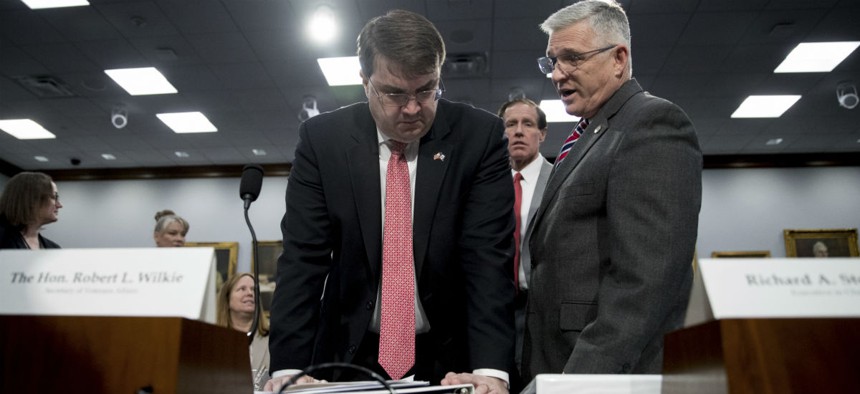VA Won’t Delay Launch of Private Care Software Tool Despite Reported Flaws

Veterans Affairs Secretary Robert Wilkie, left, speaks with Veterans Health Administration Executive in Charge, Dr. Richard Stone, at a Congressional hearing March 27. Andrew Harnik/AP
The tech will go live on June 6 even if it’s operating “at 70 percent or 50 percent,” said Secretary Robert Wilkie.
The Veterans Affairs Department is pressing ahead with a software tool that would help connect vets with private providers despite serious concerns about the quality of the tech.
Veterans Affairs Secretary Robert Wilkie on Wednesday told lawmakers the department remains on schedule to roll out the tool on June 6 even after an internal review raised doubts about whether it’s ready for launch.
The system, which would help VA doctors direct vets to appropriate private medical providers, would play a critical role in a new initiative to expand veterans’ private sector health care options under the MISSION Act.
“We’re going to be implementing MISSION Act even if the decision support tool is [operating] at 70 percent or 50 percent,” Wilkie told the House Veterans Affairs Committee. “Our people have been trained on how to work with our veterans ... and get them out into the [private health care] community if we do not have that particular service.”
A U.S. Digital Service assessment, first released by ProPublica, found the tool was likely to generate errors, run slowly or even crash if used within the agency’s IT infrastructure. These issues could ultimately lengthen doctors appointments, thereby reducing the number of patients doctors could see each day.
While Wilkie didn’t entirely refute the USDS review, he said the report was still a draft version and critiqued the methods by which it was released to the public. Committee leaders have previously requested the department send them any other internal assessments conducted by USDS, but the administration has debated whether the service and its work falls under the jurisdiction of Veterans Affairs or the Office of Management and Budget.
During the hearing, Wilkie and other officials also offered details on the agency’s fledgling effort to adopt the medical supplies procurement system used by the Defense Department. The department’s 2020 budget request includes $36 million to pilot the program at a small number of facilities.
The agency doesn’t have a final cost estimate for the modernization effort, but the project is intended to pay for itself through supply chain cost savings, said Dr. Richard Stone, the executive in charge of the Veterans Health Administration.
NEXT STORY: USDA Launches New Features on Farmers.gov






